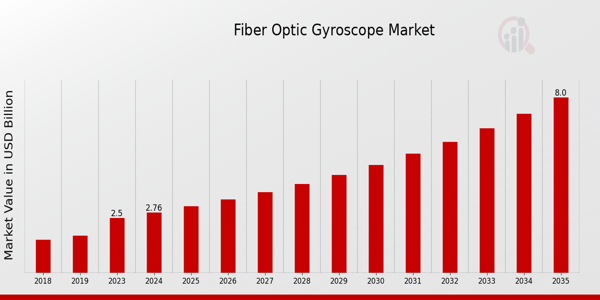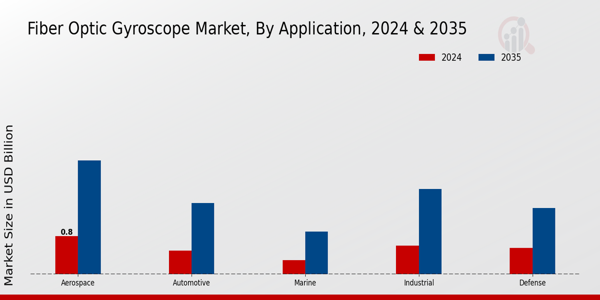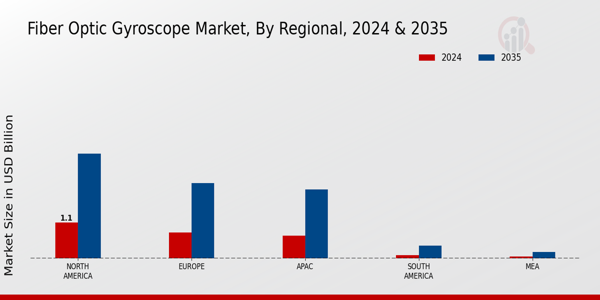Fiber Optic Gyroscope Market Overview:
Fiber Optic Gyroscope Market Size was estimated at 2.5 (USD Billion) in 2023. The Fiber Optic Gyroscope Industry is expected to grow from 2.76 (USD Billion) in 2024 to 8.0 (USD Billion) by 2035. The Fiber Optic Gyroscope Market CAGR (growth rate) is expected to be around 10.16% during the forecast period (2025 - 2035).
Key Fiber Optic Gyroscope Market Trends Highlighted
The Fiber Optic Gyroscope Market is experiencing strong growth, driven by several key factors. The increasing demand for high-precision navigation systems in aerospace and defense applications is one of the primary market drivers. As technologies evolve, the need for accurate and reliable measurement solutions has intensified. Furthermore, the growing adoption of autonomous vehicles and advancements in robotics are fueling the demand for fiber optic gyroscopes, as these devices provide crucial orientation and stabilization capabilities. Additionally, the rising interest in IoT applications and smart technologies is creating pathways for market expansion. Several opportunities are emerging within this market that manufacturers and businesses could capture. There is a significant potential for innovation in the development of compact and cost-effective fiber optic gyroscopes. Enhanced integration with other sensor technologies offers avenues for creating more advanced systems that meet modern consumer expectations.
Moreover, expanding into emerging markets where infrastructure development is rapidly advancing presents a fruitful opportunity. With the increasing emphasis on autonomous systems in various industries, tapping into these trends can lead to substantial growth and market presence. Recently, there has been a notable shift toward miniaturization and efficiency in fiber optic gyroscopes. Manufacturers are working on improving the performance of these devices while reducing size and power consumption. The introduction of new materials and technologies to enhance sensitivity and reliability has also gained traction. Additionally, collaborations between technology firms and research institutions are leading to innovative applications, such as in consumer electronics and wearable devices. As the market evolves, attention to sustainability and energy-efficient solutions is becoming more prevalent, indicating a broader trend toward environmentally friendly technology developments.

Source: Primary Research, Secondary Research, MRFR Database and Analyst Review
Fiber Optic Gyroscope Market Drivers
Increasing Demand for Navigation Systems
The Fiber Optic Gyroscope Market Industry is experiencing substantial growth driven by the increasing demand for sophisticated navigation systems across various sectors, including aerospace, defense, and automotive. As technology advances, the need for highly accurate and reliable navigation solutions continues to rise. Fiber optic gyroscopes offer superior performance in terms of precision and reliability compared to traditional gyroscopic technologies. This enhanced precision is crucial in applications where even minor deviations can lead to significant consequences, such as military operations and commercial aircraft navigation. Furthermore, the integration of fiber optic gyroscopes in consumer electronics and unmanned aerial vehicles (UAVs) is becoming increasingly prevalent, reflecting the broader trend of digital transformation across industries. As economies expand and sectors such as aerospace and automotive seek to innovate, the Fiber Optic Gyroscope Market Industry is well-positioned to capitalize on this demand for advanced navigation systems, ensuring both short-term and long-term growth prospects.
Technological Advancements
Technological advancements in fiber optic gyroscope devices are continuously enhancing their capabilities and performance in the Fiber Optic Gyroscope Market Industry. These innovations include improvements in sensitivity, stability, and the reduction of size and weight, making them more adaptable for various applications. As organizations seek cutting-edge solutions for their operational challenges, fiber optic gyroscopes are becoming a preferred choice due to their superior performance metrics. Manufacturers are increasingly investing in research and development to push the boundaries of what these devices can achieve, which fuels market growth.
Growth in the Aerospace and Defense Sector
The growth in the aerospace and defense sectors is a significant market driver for the Fiber Optic Gyroscope Market Industry. These sectors require highly accurate and reliable sensor systems for navigation and positioning applications. Fiber optic gyroscopes are becoming an essential technology in this field, as they offer unparalleled precision and robustness in demanding conditions. Increased defense budgets and rising investments in aircraft technology further propel the demand for fiber optic gyroscopes, indicating a strong outlook for the future.
Fiber Optic Gyroscope Market Segment Insights:
Fiber Optic Gyroscope Market Application Insights
The Fiber Optic Gyroscope Market is witnessing substantial growth, driven by increasing applications across various sectors. In 2024, the market is valued at 2.76 USD Billion, and as it progresses towards 2035, this figure is expected to reach 8.0 USD Billion, displaying robust demand across its diversified applications. Within this landscape, there are several distinct applications, namely Aerospace, Automotive, Marine, Industrial, and Defense, each contributing to the overall market dynamics. The Aerospace sector holds a significant position, with a market valuation of 0.8 USD Billion in 2024, surging to 2.4 USD Billion by 2035, indicating its reliance on advanced gyroscopic technology for navigation and stability in aircraft. The Automotive sector is also notable, valued at 0.5 USD Billion in 2024 and expected to grow to 1.5 USD Billion in 2035, driven by the heightened focus on safety, navigation systems, and the increasing prevalence of autonomous vehicles that require precise sensing technologies.
The Marine application segment, while smaller in comparison, is projected to increase from 0.3 USD Billion in 2024 to 0.9 USD Billion by 2035, indicating the growing importance of gyroscopes in navigation and positioning for both commercial and military vessels. Industrial applications are expected to witness notable growth, beginning at 0.6 USD Billion in 2024 and reaching 1.8 USD Billion in 2035, reflecting the ongoing automation trends and the need for accurate motion sensing in various machinery and equipment. Lastly, the Defense sector, valued at 0.56 USD Billion in 2024 and expected to grow to 1.4 USD Billion by 2035, demonstrates the critical role that fiber optic gyroscopes play in ensuring accuracy and reliability in defense applications, especially in guidance systems. Each of these segments showcases its unique drivers and challenges, but collectively, they highlight the essential role that fiber optic gyroscopes play in modern technology across various industries.
The predominance of the Aerospace sector indicates a major investment in research and development, showcasing its dominance due to high accuracy and reliability requirements in navigation systems, establishing it as a leader in the Fiber Optic Gyroscope Market revenue. The shifting dynamics suggest that the growth will be spurred by technological advances, increased demand for precise navigation, and expanding applications in emerging markets, reflecting the diverse nature of the Fiber Optic Gyroscope Market segmentation.

Source: Primary Research, Secondary Research, MRFR Database and Analyst Review
Fiber Optic Gyroscope Market Type Insights
The Fiber Optic Gyroscope Market is poised for notable growth, with a market value reaching 2.76 USD Billion in 2024. Significant factors driving growth include advancements in technology and increasing demand across various industries, including aerospace, defense, and automotive. The market segmentation for Fiber Optic Gyroscopes includes categories such as Rugged Fiber Optic Gyros, Non-Rugged Fiber Optic Gyros, and Miniature Fiber Optic Gyros, each serving unique applications. Rugged Fiber Optic Gyros are recognized for their durability, making them ideal for harsh environment applications, such as military and aerospace, ensuring reliable performance under extreme conditions. Miniature Fiber Optic Gyros are gaining traction in sectors like robotics and drones, where space and weight constraints prevail, while Non-Rugged Fiber Optic Gyros cater to less demanding environments like consumer electronics. These segments together reflect the growing diversity and specialization within the Fiber Optic Gyroscope Market, adapting to evolving technological requirements and market demands. Ongoing innovations and the practical utility of each type ensure strategic developments for stakeholders in the Fiber Optic Gyroscope Market, highlighting opportunities for enhanced functionality and increased revenue from various industrial applications.
Fiber Optic Gyroscope Market Technology Insights
The Fiber Optic Gyroscope Market is experiencing significant growth, with a noteworthy valuation of 2.76 billion USD in 2024, poised to reach 8.0 billion USD by 2035. The increasing demand for precision and reliability in navigation and positioning systems across various industries drives this market. The market segmentation highlights different technologies within fiber optic gyroscopes, such as Single Mode Fiber Optic Gyroscopes, Multimode Fiber Optic Gyroscopes, and Laser Fiber Optic Gyroscopes. The Single Mode Fiber Optic Gyroscopes hold a dominant position due to their superior performance in applications requiring high sensitivity and low noise. Likewise, the Multimode Fiber Optic Gyroscopes cater to a diverse range of applications, providing versatility and effectiveness. Meanwhile, Laser Fiber Optic Gyroscopes are recognized for their cutting-edge technology, playing a crucial role in the market with their advanced capabilities. As market growth continues, these technologies are expected to meet the evolving challenges of accuracy and reliability in high-performance applications. The increasing adoption of these technologies across various sectors presents ample opportunities for advancements, solidifying the market's trajectory toward sustained growth.
Fiber Optic Gyroscope Market End-Use Insights
The end-user segment of the Fiber Optic Gyroscope Market plays a critical role, contributing significantly to the overall market dynamics. In 2024, the market reached a value of 2.76 USD Billion and is projected to grow rapidly, showcasing the increasing reliance on advanced technologies in various applications. Key areas within this segment include Navigation, Stabilization, Staging, and Guidance Systems, with Navigation often holding a major share due to its essential role in the transportation and aerospace industries. Stabilization systems leverage fiber optic gyroscopes for enhanced precision, addressing the need for stability in both military and commercial applications. Guidance Systems, which utilize these gyroscopes for accurate positioning, are gaining prominence in both autonomous vehicles and robotics. The Fiber Optic Gyroscope Market data reflects trends such as rising technological advancements and expanding defense spending, while challenges may come from high manufacturing costs. With increasing demand for improved navigational accuracy and reliability across sectors, opportunities abound for growth within this segment, further driving the overall market growth and shaping future market statistics.
Fiber Optic Gyroscope Market Regional Insights
The Fiber Optic Gyroscope Market exhibits significant growth potential across various regions, with North America holding a notable position with a market valuation of 1.1 USD Billion in 2024 and expected to rise to 3.2 USD Billion by 2035. This dominance can be attributed to advanced technology adoption and strong defense spending. Europe follows, valued at 0.8 USD Billion in 2024 and reaching 2.3 USD Billion in 2035, fueled by increasing demand in the aerospace and automotive sectors. APAC, valued at 0.7 USD Billion in 2024 and projected to grow to 2.1 USD Billion by 2035, reflects the region's rapid industrialization and urbanization driving market growth. Meanwhile, South America and MEA represent smaller segments, valued at 0.1 USD Billion and 0.06 USD Billion in 2024, respectively, with future projections of 0.4 USD Billion and 0.2 USD Billion by 2035. These regions show potential for growth but face challenges such as economic instability and limited technological infrastructure. Overall, the Fiber Optic Gyroscope Market segmentation highlights North America and Europe as leading regions, while APAC demonstrates significant opportunities driven by increasing investments and modernization efforts.

Source: Primary Research, Secondary Research, MRFR Database and Analyst Review
Fiber Optic Gyroscope Market Key Players and Competitive Insights:
The Fiber Optic Gyroscope Market is characterized by significant growth and innovation, driven by advancements in technology and increasing demand across various sectors, including aerospace and defense, telecommunications, and automotive. This market has witnessed intense competition among key players striving to enhance their product offerings and gain competitive advantages through research and development as well as strategic partnerships. The rise in navigation systems and the growing adoption of fiber optic gyroscopes for inertial measurement units have also contributed to the competitive landscape, with firms vying to capture larger market shares by focusing on the performance, accuracy, and cost-effectiveness of their products. The interconnectedness of various sectors utilizing these technologies has made competition not just about product differentiation but also about fulfilling diverse regulatory and operational requirements for various applications, which further compounds the competitive dynamics within this sector.
Rohde Schwarz is a prominent player in the Fiber Optic Gyroscope Market, recognized for its strong emphasis on precision and innovation in measurement technology. The company's portfolio in the gyroscope market includes advanced fiber optic gyroscopes known for their high sensitivity levels and reliability, which cater to demanding applications such as avionics and military-grade navigation systems. Rohde Schwarz leverages its extensive experience in the field of telecommunications and electronics to ensure high performance and low drift characteristics in its gyroscope offerings, strengthening its position in the market. The company's robust global presence allows it to effectively serve a broad customer base while continuously enhancing its product line to meet the evolving requirements of industries that rely on cutting-edge navigation technology.
Murata Manufacturing stands out in the Fiber Optic Gyroscope Market due to its commitment to delivering high-quality, reliable components utilized in various applications, including consumer electronics and automotive systems. Murata's advancements in miniaturization and integration of fiber optic gyroscopes into compact solutions have made a significant impact on the market by providing users with space-efficient options that do not compromise performance. The company's focus on research and development enables it to introduce innovative gyroscope technologies that enhance accuracy and response time, thus meeting the growing demand for precision in navigating systems. Murata's global footprint not only facilitates its competitive edge but also ensures a steady supply chain, which is vital in maintaining long-term relationships with customers who demand durability and reliability in their navigation solutions.
Key Companies in the Fiber Optic Gyroscope Market Include:
- Rohde Schwarz
- Murata Manufacturing
- IIVI Incorporated
- Ofabs
- Safran
- Furukawa Electric
- OptoSpeed
- Ametek
- Honeywell
- Northrop Grumman
- Kilopass Technology
- Emcore Corporation
- GS Micro
- FLEXpoint Sensor Systems
- Thales Group
Fiber Optic Gyroscope Industry Developments
The Fiber Optic Gyroscope Market has recently seen several significant developments. Companies like Rohde Schwarz and Honeywell are actively enhancing their product offerings to meet increasing demand in the aerospace and defense sectors. Murata Manufacturing has focused on advancing its gyroscope technologies, while Safran is noted for its innovative solutions that cater to navigation systems. Notably, recent mergers and acquisitions have shaped the competitive landscape, with IIVI Incorporated expanding its portfolio through strategic partnerships aimed at bolstering its market presence. Furukawa Electric has also been enhancing its capabilities, which has positively impacted market valuations.
Meanwhile, Northrop Grumman and Thales Group are investing in emerging technologies to optimize the performance and reliability of fiber optic gyroscopes. The market has witnessed a growth in valuation due to increased adoption across various applications, particularly in robotics and autonomous systems. These trends reflect a burgeoning interest in advanced navigation solutions as players like Ametek and Emcore Corporation continue to innovate. The overall outlook remains optimistic as demand for precision instrumentation drives technological advancements within the fiber optic gyroscope industry. When combined, these developments underscore a dynamic environment poised for continued growth and innovation.
Fiber Optic Gyroscope Market Segmentation Insights
Fiber Optic Gyroscope Market Application Outlook
- Aerospace
- Automotive
- Marine
- Industrial
- Defense
Fiber Optic Gyroscope Market Type Outlook
- Rugged Fiber Optic Gyros
- Non-Rugged Fiber Optic Gyros
- Miniature Fiber Optic Gyros
Fiber Optic Gyroscope Market Technology Outlook
- Single Mode Fiber Optic Gyroscopes
- Multimode Fiber Optic Gyroscopes
- Laser Fiber Optic Gyroscopes
Fiber Optic Gyroscope Market End-Use Outlook
- Navigation
- Stabilization
- Staging
- Guidance System
Fiber Optic Gyroscope Market Regional Outlook
- North America
- Europe
- South America
- Asia-Pacific
- Middle East and Africa
|
Report Attribute/Metric
|
Details
|
|
Market Size 2023
|
2.5 (USD Billion)
|
|
Market Size 2024
|
2.76 (USD Billion)
|
|
Market Size 2035
|
8.0 (USD Billion)
|
|
Compound Annual Growth Rate (CAGR)
|
10.16% (2025 - 2035)
|
|
Report Coverage
|
Revenue Forecast, Competitive Landscape, Growth Factors, and Trends
|
|
Base Year
|
2024
|
|
Market Forecast Period
|
2025 - 2035
|
|
Historical Data
|
2019 - 2023
|
|
Market Forecast Units
|
USD Billion
|
|
Key Companies Profiled
|
Rohde Schwarz, Murata Manufacturing, IIVI Incorporated, Ofabs, Safran, Furukawa Electric, OptoSpeed, Ametek, Honeywell, Northrop Grumman, Kilopass Technology, Emcore Corporation, GS Micro, FLEXpoint Sensor Systems, Thales Group
|
|
Segments Covered
|
Application, Type, Technology, End Use, Regional
|
|
Key Market Opportunities
|
Increased demand in aerospace applications, Growing autonomous vehicle adoption, Expansion in defense and military sectors, Advancements in consumer electronics integration, Rising demand for IoT and connectivity.
|
|
Key Market Dynamics
|
Increasing demand for precision navigation, Growth in aerospace and defense applications, Advancements in sensor technology, Rising adoption of autonomous vehicles, Expanding telecommunications infrastructure
|
|
Countries Covered
|
North America, Europe, APAC, South America, MEA
|
Frequently Asked Questions (FAQ) :
The Global Fiber Optic Gyroscope Market was valued at 2.76 USD Billion in 2024.
By 2035, the market is projected to grow to 8.0 USD Billion.
The market is expected to register a CAGR of 10.16% from 2025 to 2035.
The Aerospace application segment is valued at 0.8 USD Billion in 2024.
Major players in the market include Rohde Schwarz, Murata Manufacturing, and Honeywell.
The Industrial application segment is forecasted to reach a value of 1.8 USD Billion in 2035.
The South American market is expected to grow to 0.4 USD Billion by 2035.
The APAC region is anticipated to hold a market value of 2.1 USD Billion in 2035.
















